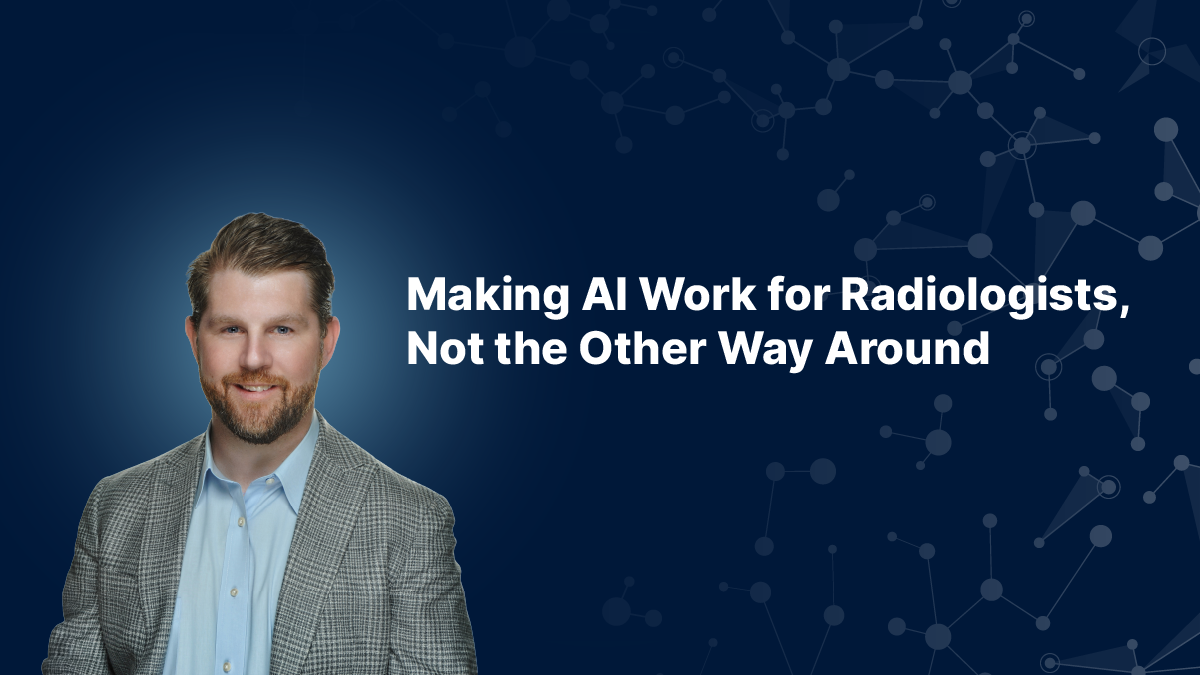Making AI Work for Radiologists, Not the Other Way Around


Kevin Field recently joined Rad AI as Chief Revenue Officer, bringing deep experience leading sales at high-growth healthcare and technology companies. He sees radiology at a turning point, where rising demand, workforce strain, and the rapid evolution of AI are reshaping how care is delivered.
In this Q&A, Kevin shares what drew him to Rad AI, how he thinks about building trust in a noisy market, and what health system leaders should consider as they evaluate AI partners.
You’ve led sales at multiple high-growth companies. What drew you to Rad AI and what did you see in radiology that felt like a rare opportunity?
What drew me to Rad AI was the combination of a mission-driven team, a product that delivers real impact, and an industry at a true inflection point. In every conversation with the team, I could feel how much talent and passion there is here. People aren’t just working on AI for the sake of AI. They care deeply about using our collective talents to make an impact. Helping physicians and patients downstream fired me up and spoke to me on a personal level.
The customer base also said a lot. With so much hype around AI, it’s hard to tell what’s real and what’s not. Rad AI isn’t a fly-by-night vendor. We’re ahead of the curve. Continuing to scale that and help take the industry into the next evolution with more efficient tools is meaningful work.
Finally, I was drawn to the strong clinical voice here. Jeff, our co-founder, is a radiologist, and we have multiple CMIOs integrated into every part of our customer journey. The best clinical solutions are built hand-in-hand with clinicians.
There’s a lot of noise in the healthcare AI market. How are you thinking about building trust and cutting through hype when engaging with health system and radiology leaders?
In healthcare, adoption happens at the speed of trust. No matter how good your product is, if leaders don’t believe in you, the deal will not move forward.
We’ve built trust by doing the hard work: sitting in committee meetings, understanding unique workflows, navigating IT reviews, and proving our value repeatedly based on what customers need. That experience shows we know how to operate in their world and understand their realities and pressures.
Our principles are simple: be proactive, be thoughtful, and be honest.
That means helping customers navigate buying requirements to make their lives easier, showing empathy for their process and what we are solving together, and being straightforward about what works and what doesn’t.
I would rather lose a deal than overpromise, because credibility is everything. What cuts through hype is consistency.
What’s one conversation with a radiology leader that’s really stuck with you since joining Rad AI?
I recently spoke with a radiologist I’ve known since we were kids. I asked him to walk me through his day, from his first coffee to the end of his shift, and what struck me was the relentlessness. The steady stream of studies, the pressure from the ED, and the expectation to move quickly without ever sacrificing accuracy.
What stayed with me most was the cognitive burden. Radiology is not only about reading scans. It is juggling constant interruptions, making decisions under fatigue, and carrying the weight of knowing every call impacts a patient. By the end of the day, many radiologists are completely drained.
That conversation reinforced why Rad AI matters. Radiologists do not need more complexity. They need tools that lighten the mental load and create space to focus on the work that truly matters. If we can do that, we are not just improving efficiency, we are making the profession sustainable and restoring joy to the practice.
How are enterprise buyers evolving and what does the modern buying journey look like in imaging and radiology?
Right now it is a moving target. An independent radiology group moves faster and can operate more like a bottom-line business. Health systems are more complex. They are still defining how to evaluate and purchase AI, and every system has its own committees and requirements.
That makes the buying journey highly variable. For some, ROI is the priority. For others, it is burnout reduction, throughput, or accuracy. Our job is to adapt, align with their clinical goals, work within their process, and define success on their terms.
The bottom line is it has to be about the customer, not about Rad AI.
AI adoption often stalls due to workflow friction. How are you and your team tackling that in the sales process?
Workflow friction is a constant in healthcare. When technology does not align with clinical routines, adoption fails. Our philosophy is simple: meet the friction head-on and make it work.
That means delivering value in two ways. First, by addressing the immediate needs of radiology teams around efficiency, burnout, and financial sustainability. Second, by showing how AI can open the door to a more sustainable and future-ready model of care. Adoption only lasts if both are addressed.
In the end, our role is not to push software. It is to ensure our solutions create real, measurable impact in radiology departments. That is how partnerships are built and trust is earned.
Speed-to-value is a major theme right now. How are you aligning the go-to-market motion to prove ROI faster?
Customers want results quickly, and they can tell almost immediately if a solution is delivering. That is why we focus on getting them to “green” status as early as possible. At that point, the value is clear, radiologists are talking about their experience, and leadership can see the data to back it up.
One of my favorite stories came from a radiologist who told me his wife could tell the difference in his mood on days he used Rad AI compared to other tools. That is not just ROI, that is a better quality of life.
When things do not go smoothly, we take accountability and resolve them fast. Customers do not want to feel like a line item in a spreadsheet. They want a partner who delivers, who cares, and who takes ownership. That is exactly how we approach every engagement.
If you could offer one piece of advice to radiology groups or imaging departments evaluating AI, what would it be?
AI adoption sounds simple in theory but it is hard in practice. My advice is to look at three things:
- Execution today. Can the vendor actually deliver on what they have promised right now?
- Vision tomorrow. AI will evolve faster than most technologies. You need a partner who is innovating in the right direction.
- Balance. The best partners blend focus with innovation. Too much of one without the other, and adoption will not last.
At the end of the day, choosing an AI partner is not a technology decision. It is a decision about who you trust to stand with you today and to grow with you tomorrow.






